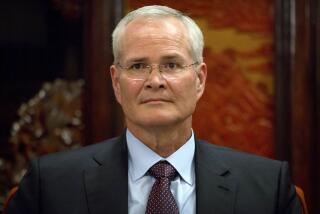Auditor, Execs Target of Enron Creditors
Professional services firms--everyone from accountants Arthur Andersen to law firms and financial consultants--are quickly coming into the sights of creditors and shareholders looking to staunch losses from the failure of Enron Corp., once the nation’s largest energy trading company.
Because Enron’s liabilities are expected to exceed its assets by billions of dollars, advisors, executives and wealthy directors of the company will be the likely sources of compensation, according to bankruptcy experts.
Two executives, Chairman Kenneth L. Lay, and former Chief Executive Jeffrey K. Skilling, will be high on the list of targets, experts say.
Lay has netted at least $150 million from exercising Enron stock options over the last two years, according to Securities and Exchange Commission documents. Skilling collected more than $62 million last year in options gains.
More than 200 government agencies used a similar strategy of filing lawsuits against advisors and auditors to win $860 million in settlements after the 1994 bankruptcy of Orange County. More than $400 million came from Merrill Lynch. The KPMG Peat Marwick accounting firm paid $61.4 million. Law firms and other Wall Street investment banks contributed the remainder.
“This gives me a sense of deja vu ,” said John Moorlach, Orange County’s treasurer and one of the architects of the county’s recovery strategy.
How much money will be lost in the Enron debacle won’t be known until much later in what analysts are calling an inevitable bankruptcy filing, which could come as soon as today.
Enron’s shares closed Thursday at 36 cents, down 25 cents on the New York Stock Exchange. They traded close to $85 in December 2000.
Some experts have estimated that Enron’s liabilities exceed its assets by $5 billion or more. However, analyst Carol Levenson of Gimme Credit, a New York bond-research firm, said, “We really don’t know what all their liabilities may turn out to be.”
Rep. John D. Dingell (D-Mich.), ranking Democrat on the House Energy Committee, this week called for an investigation of Arthur Andersen’s role in the Enron collapse and in the turmoil that beset a previous Andersen client, Waste Management Inc.
Arthur Andersen, Enron’s outside auditor, will be the No. 1 target. This month, Enron shocked Wall Street by restating earnings for the last four years, acknowledging that it had overstated profit by $580 million.
“It’s safe to predict that there will be a settlement with Arthur Andersen,” said Lynn LoPucki, a UCLA bankruptcy law professor. “It seems impossible for them to be completely clean in this.”
LoPucki, however, isn’t sure that claimants will be able to get any more than “several hundred million dollars” out of Andersen. He said there is a limit to how much the accounting firm could pay out and still remain a viable entity.
The record settlement for an accounting firm, not including agreements with the federal government over flawed savings and loan audits a decade ago, came in 1999, when Ernst & Young paid $335 million to Cendant Corp. shareholders to settle charges that its financial statements inflated the earnings of a predecessor company.
Mark Cheffers, a former PriceWaterhouse auditor who operates the accounting liability training company AccountingMalpractice.com, said fallout from Enron has the potential to be even larger and could put Arthur Andersen out of business.
“Clearly they are vulnerable,” he said. “There is a high probability that they were involved in setting up the partnerships and entities that are now under question. Andersen is one of the premier firms in the world that deals with this type of structure.”
Moreover, Enron has disclosed that it paid Andersen $25 million in audit fees annually and an additional $27 million for non-audit services, Cheffers said. Those extra services will become the subject of intense scrutiny.
The total payments--equal to $1 million a week--won’t look good in any potential civil trials.
“As a general rule, a jury will look at that and decide that Andersen was no longer independent of Enron,” Cheffers said.
As they seek to recover losses, Enron creditors probably will form a committee to go after one of the smaller organizations or parties involved in the company’s insolvency.
“You pick one to go after first to get a war chest to go after the bigger parties,” said Kenneth Klee, a bankruptcy expert at the Century City law firm of Klee, Tuchin, Bogdanoff & Stearn.
Klee’s firm is using that strategy to recover funds in the August 2000 bankruptcy of Iridium, a satellite communications venture of Motorola Inc.
“We never actually sued the banks involved,” Klee said.
“We just made our case to them and they gave us a settlement that is funding the litigation against Motorola.”
The efforts of creditors and shareholders to collect damages will set off a donnybrook with constantly shifting sets of alliances and interests.
“Who will get what depends on the type of the loss and who inflicted it,” said LoPucki, the law professor.
For example, stockholders who have targeted Enron in recent lawsuits fall mainly into two categories: Enron employees, who held shares in their retirement accounts, and ordinary investors, who bought the stock directly or through mutual funds.
Their suits have the same goal--recovering billions of dollars of losses--but they are targeting different defendants and acting under different legal theories, said Karl Barth, a partner in Seattle law firm Hagens Berman, which represents Enron employees.
The employees say Enron and the executives who administer its 401(k) retirement plan violated federal retirement laws by, among other things, misleading the workers about Enron’s financial condition and barring them from selling their stock as it plunged to pennies a share, Barth said.
Their lawsuit also names as a defendant Northern Trust Co. of Chicago, which Enron hired to manage the 401(k) plan and which presumably implemented the “lockout” that kept workers from selling their stock during the critical period, Barth said.
Although Barth believes Arthur Andersen bears responsibility for approving some of Enron’s questionable off-balance-sheet deals, he said it is unclear whether Andersen had a fiduciary duty to the employees under federal retirement account law.
“We’re still researching that,” he said.
The ordinary investors have a wider cast of potential defendants to pursue but narrower legal grounds on which to base their case, legal experts said.
The so-called shareholder-derivative lawsuits have to show that the company, its officers or others acting on its behalf committed fraud by intentionally deceiving investors about the company’s prospects and financial condition, experts said.
*
RELATED STORY
Inquiry: Congress begins probe into Enron’s collapse. A1
More to Read
Inside the business of entertainment
The Wide Shot brings you news, analysis and insights on everything from streaming wars to production — and what it all means for the future.
You may occasionally receive promotional content from the Los Angeles Times.











